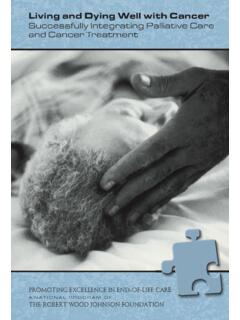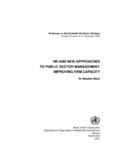Transcription of Respiratory care of the patient with amyotrophic lateral ...
1 Appendix D Symptom Management Appendix D Table of Contents Respiratory 2 Nutritional Care and 17 Augmentative and Alternative Communication in ALS 33 Depression and Pseudobulbar Effects 46 Pain Management 51 Insomnia in ALS 58 Care of the Dying patient with ALS 61 1 Appendix D Symptom Management Symptom Management During the End of Life in ALS Respiratory Care of The patient with amyotrophic lateral sclerosis During the End-of-Life Period Respiratory failure associated with ALS is mainly due to Respiratory muscle weakness.
2 Respiratory symptoms usually develop late in the disease process and in conjunction with extremity or bulbar muscle involvement. A few patients with ALS present with Respiratory symptoms initially; this is due to involvement of the phrenic motor neurons. Respiratory insufficiency can be either insidious or acute, often precipitated by infection or aspiration. Toward the terminal phase of the disease, an accelerated decrease of the pulmonary vital capacity takes place. Decreases in ventilation occur initially at night and only later, during the day. Many patients with ALS die at night, presumably as a result of an exacerbation of nocturnal hypoventilation.
3 Despite the frequency of Respiratory failure in the patient with ALS, management of Respiratory care at the end of life has not been well studied. This section summarizes recommendations based on the evidence currently available in the literature. An analysis of the current understanding of evidence-based practice recommendations also helps in identifying areas needed for future research. WORKGROUP FINDINGS Respiratory Function Assessment Assessing pulmonary function and Respiratory failure in patients with ALS is challenging because the ability to execute accurate spirometric testing becomes more difficult with increasing disability and disease progression.
4 Use of a facemask rather than a mouthpiece may be helpful in obtaining spirometry, however this has not been studied scientifically. An overview of the anatomy and pathophysiology of Respiratory failure is detailed in Table I. Other Respiratory symptoms, other than dyspnea, are often present and may require medical attention during the end of life. Other Respiratory symptoms include cough, excessive secretions, choking and laryngospasm. Pulmonary function testing is invaluable in assessing the level of Respiratory impairment, following disease progression and assessing prognosis in ALS. Fallat and colleagues evaluated comprehensive pulmonary function testing over time, in 218 patients with ALS (Fallat et al.)
5 , 1987). All of their patients showed evidence of restrictive lung disease with reduction in total lung capacity (TLC), forced vital capacity (FVC), forced expiratory volume in 1 second (FEV1) and maximum voluntary ventilation (MVV). The FVC averaged 80% of predicted at presentation to their clinic. They were able to follow pulmonary function tests in 103 patients, and the results showed that these patients had significant decrements in all values over time. Black and Hyatt studied Respiratory muscle function in ALS with dyspnea and near normal vital capacity (Black and Hyatt, 1971). Maximal inspiratory (MIP) and maximal expiratory (MEP) pressures were markedly reduced (34% and 47%, respectively).
6 In these patients, reduction in maximal muscle strength correlated well with sensation of dyspnea, despite near normal vital capacity. Nocturnal hypoventilation and sleep disordered breathing is a common problem for patients with ALS (Chokroverty, 1996; Culebras, 1996; David et al., 1997; Ferguson et al., 1996; Barthlen, 1997; Hetta, Jansson, 1997). This can occur even when Respiratory muscle function is only mildly affected and daytime gas exchange remains normal. Neural output to the Respiratory system normally decreases during sleep. Even mild muscle weakness coupled with the normal decreases in ventilatory drive can result in nocturnal hypoventilation and disturbed sleep architecture (Gay et al.)
7 , 1991). Symptoms and signs of 2 Appendix D Symptom Management nocturnal hypoventilation can manifest both at night and during the day. Nighttime symptoms include air hunger, observed apneas, orthopnea, cyanosis, restlessness and insomnia. Daytime findings include excessive sleepiness, morning headaches or drowsiness, polycythemia and pulmonary hypertension. The health care provider should be vigilant for these symptoms, which the patient may not spontaneously volunteer. Sleep studies can be very helpful in elucidating sleep disturbed breathing in these patients if doubt remains.
8 In addition to symptoms of hypoventilation, patients often complain of episodes of choking, cough, excess secretions and laryngospasm. Although these symptoms are known to occur, little is known of their effect on quality of life or the best treatment modalities. Status of Knowledge of Respiratory Dysfunction During the End-of-Life Period The recently published Practice Parameter of the American Academy of Neurology (AAN) for the care of ALS patients emphasizes Respiratory care during the initial and intermediate phases of ALS, and acknowledges a paucity of information at the end of life (Miller et al., 1999). This Practice Parameter addressed whether terminal dyspnea was relieved by therapeutic intervention, and whether there was an optimal method of withdrawing noninvasive and invasive ventilation.
9 The fear of ventilator dependency and of patients reaching a locked-in state, in which they are alert but unable to communicate, limited the widespread use of tracheostomy-ventilator (TV). It was thought that the use of non-invasive ventilation ( , NIPPV) would avoid this situation, as the technique was not thought capable of 24-hour use. However, it has become evident that patients can survive for many years with 24-hour NIPPV, particularly if techniques are used to optimally clear secretions (Bach, 1995). One of the challenges of ventilatory support is making the decision to discontinue support during the end of life. Patients should be aware that they can discontinue NIPPV, and that severe breathlessness and anxiety can be avoided by premedication with opiates and anxiolytics.
10 A more satisfactory alternative to abrupt discontinuation of NIPPV is to employ terminal weaning. In terminal weaning, the settings of the ventilator are adjusted to maintain symptomatic relief but to allow gradual hypercapnia to develop; it is often done in combination with opioids and anxiolytics in order to reduce anxiety, dyspnea, pain and suffering. Careful assessment of the patient 's symptoms and comfort level (frequently requiring home visits) is necessary to insure that removal of NIPPV does not actually add to anxiety and dyspnea. Very little is known about the optimum care of Respiratory symptoms in the last few days of life for patients who use NIPPV.








